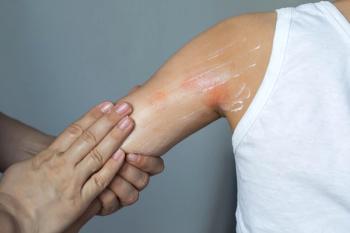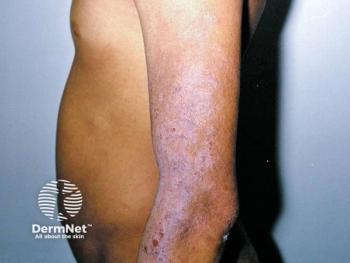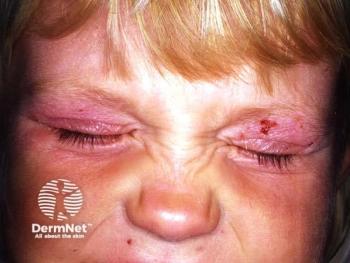
Atopic Dermatitis: Practical Advice on Selecting and Using JAK Inhibitors
Concluding their focused discussion on JAK inhibitors in atopic dermatitis, panelists share advice on the optimal selection based on route of administration and use of these agents.
Episodes in this series

Transcript:
Christopher G. Bunick, MD, PhD: Dr Cohen, to what extent do routes of administration and frequency of administration affect the use and selection of topical or oral JAK inhibitors?
Jeffrey Cohen, MD: This is a very important concept. As we’ve discussed, the topical and oral JAK inhibitors occupy different rungs of our treatment ladder. The topical JAK inhibitors can be really good for patients who have areas of body involvement easily addressed by topical medications but who haven’t had the ideal response to the other topical medications, either steroid or nonsteroid, that we have. Maybe they couldn’t tolerate those or maybe they needed them for too long—longer than we felt comfortable having them use them. Whereas the JAK inhibitor topical can be used for longer than 2 to 3 weeks—up to 8 weeks was studied in the trial. That seems to be fairly safe, and it can be used on and off as needed. I’ve also found that for patients on other systemic medications, such as dupilumab, who have areas of breakthrough or areas that appear to be stubborn and don’t get better with that other medication, I’ve had them do very well with the addition of topical ruxolitinib to those particular areas to help gain some clearance and address areas that just weren’t addressed before.
Route of administration can be important for other reasons, though. Some patients do a great job with topical medications and like using topical medication. Others have a lot of difficulty putting that into their daily routine. We like to say, “Use this twice a day, use this 1 twice a day, use moisturizer this many times a day.” If you think about it, it’s very hard to integrate all that into your daily routine, which is already busy. You’re already trying to do everything else you need to do, and now you need to use different types of topical medications at various times in the day, which can be very difficult. So for some of those patients, an oral or injectable treatment can be a lot better.
As Dr [Peter] Lio mentioned, some people don’t do well with needles and prefer to have an oral option. They’d rather take an oral medication daily than inject themselves once every 2 weeks. Many of them aren’t happy to understand that that still involves some needles for laboratory monitoring, but for some people that’s a preferred approach.
We have to think about JAK inhibitors in part of the treatment ladder where they’ve been aimed for. That is to say, the orals are meant for people who may have failed other treatment options, who have more moderate to severe disease. The topical can help with moderate or severe disease if it’s in areas we can address with the topical or if it’s to help with breakthrough, but it can also be used for milder cases where other topicals may not have been the best treatment option for various reasons.
Christopher G. Bunick, MD, PhD: Dr Cohen, you said something interesting about combining the ruxolitinib with your dupilumab to help for those areas that don’t fully go away. It made me think about something Dr Stein Gold said about the up to 8 weeks of ruxolitinib. I’m curious: in these patients, in the real-world data that we collect over the coming months, it will be interesting to see if these patients have a longer clearance using ruxolitinib for these areas of patches over 8 weeks compared with the traditional therapies we’ve discussed.
Speaking of real-world evidence, Dr Stein Gold, to conclude this segment, can you discuss your tips for managing atopic dermatitis with topical ruxolitinib or the oral JAK inhibitors more generally?
Linda F. Stein Gold, MD: Sure. As a basic recommendation, make sure it’s the right drug for the right patient. If we’re talking about the oral JAK inhibitors, for instance, you’ll want to make sure they don’t have an active infection. You’ll want to make sure they’re up to date on their vaccines; they don’t get any live vaccines. Make sure it’s not somebody who has multiple risk factors for blood clots. Just make sure you take a general history to understand what that patient’s past medical history looks like. As was mentioned, it’s interesting when we look at the package insert for ruxolitinib, which is not to be used with other systemic or biologic agents. But as was mentioned, in real life we’re going to use them together. We don’t have data. It hasn’t been studied in combination. As we start to have these drugs and use the art of medicine, we’re going to come up with practices that we think are the best approach.
Overall, we need a lot of tools in our toolbox. No 1 agent gets all patients completely controlled. We want to have that acute plan, but we also want to have that long-term game plan. Our goal is to get them under control and keep them under control. We don’t have the studies that look at maintenance therapy, but that’s something that in real life we’re going to do. We’re probably going to get these patients under control with ruxolitinib, for instance. The study hasn’t been done, but what happens if we get you under control and we use it 2 or 3 times a week to maintain control? I’ve been doing that in my practice. I don’t have any data to support it. But with the topical immunomodulators, we saw that they’re very good for maintenance therapy. I hope the other nonsteroidals will be as well. But as we use them more, we’ll learn better how to use them for the appropriate patients. These are going to allow us to get our patients under even better control.
Transcript edited for clarity.
Newsletter
Like what you’re reading? Subscribe to Dermatology Times for weekly updates on therapies, innovations, and real-world practice tips.



















